
A canyon, gorge or chasm, is a deep cleft between escarpments or cliffs resulting from weathering and the erosive activity of a river over geologic time scales. Rivers have a natural tendency to cut through underlying surfaces, eventually wearing away rock layers as sediments are removed downstream. A river bed will gradually reach a baseline elevation, which is the same elevation as the body of water into which the river drains. The processes of weathering and erosion will form canyons when the river's headwaters and estuary are at significantly different elevations, particularly through regions where softer rock layers are intermingled with harder layers more resistant to weathering.

Tourism in Indonesia is an important component of the Indonesian economy as well as a significant source of its foreign exchange revenues. Indonesia was ranked at 20th in the world tourist Industry in 2017, also ranked as the ninth-fastest growing tourist sector in the world, the third-fastest growing in Asia and fastest-growing in Southeast Asia. In 2018, Denpasar, Jakarta and Batam are among of 10 cities in the world with fastest growth in tourism, 32.7, 29.2 and 23.3 percent respectively. The tourism sector ranked as the 4th largest among goods and services export sectors.

Sof Omar Caves is the longest cave in Ethiopia at 15.1 kilometres (9.4 mi) long. When surveyed in 1972, it was the longest cave in Africa. Since then explorations in Madagascar and Algeria have overtaken it. It is situated to the east of Ginnir, in the East Bale Zone of the Oromia Region in southeastern Ethiopia, through which the Weyib River flows. It sinks at the Ayiew Maco entrance and reappears at the Holuca resurgence 1 kilometre (0.62 mi) away. According to tradition Sof Omar was the name of a Muslim holy man who lived in the area and Ayiew the name of his daughter. Maco and Holuca are local names for 'name' and "cave", respectively. Long a religious centre, it is sacred both to Islam and the local Oromo traditional religion. The caves are known for their many pillars, particularly in the "Chamber of Columns". As of 2011, the site was added on UNESCO tentative list, still to be considered for a possible inscription.
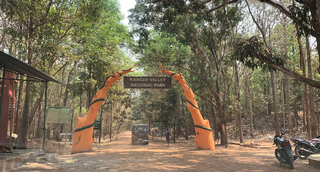
Kanger Valley National Park is a national park in the Bastar region of Chhattisgarh state in India. It came into existence in July 1982 and covers an area of approximately 200 square kilometres (77 sq mi). The park extends from the Teerathagarh waterfalls in the west to the Kolab river in the east, spanning an average length of 33.5 km (20.8 mi) and an average width of 6 km (3.7 mi) from north to south. It derives its name from the Kanger river, which flows centrally through it. Situated at a distance of 30 km (19 mi) southeast of Jagdalpur city, it is one of India's densest national parks and is known for its biodiversity, landscape, waterfalls, and subterranean geomorphologic limestone caves. It is also the home to the Bastar hill myna, the state bird of Chhattisgarh.

Sumidero Canyon is a deep natural canyon located just north of the city of Chiapa de Corzo in the state of Chiapas, in southern Mexico. The canyon's creation began around the same time as the Grand Canyon in the U.S. state of Arizona, by a crack in the area's crust and subsequent erosion by the Grijalva River, which still runs through it. Sumidero Canyon has vertical walls which reach as high as 1,000 metres (3,300 ft), with the river turning up to 90 degrees during the 13-kilometre (8 mi) length of the narrow passage.

Pangandaran is a town and district of Pangandaran Regency within the province of West Java, Indonesia. It is located on the southern coast of the island of Java. A well-known surfing beach has made Pangandaran a popular tourist destination.
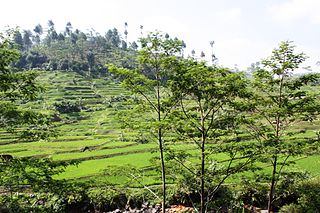
Tasikmalaya Regency is a regency in the province of West Java, Indonesia. With an area of 2,708.82 km2 (1,046 sq mi), it is the biggest and most important in the southeast region of East Preanger. Tasikmalaya Regency had a population of 1,687,776 at the 2010 census and 1,865,203 at the 2020 census; the mid-2022 official estimate was 1,906,288.

Ciamis Regency is a landlocked regency in West Java, Indonesia, and shares a provincial border with Central Java. Its seat is the town of Ciamis, also the primary urban center. Formerly, the regency included the town of Banjar, which was separated out to become an independent city on 11 December 2002; it also included areas bordering the Indian Ocean, but these southern districts were cut off to form a separate Pangandaran Regency on 25 October 2012. The regency now covers 1,597.67 km2, and had a 2020 census population of 1,229,069,> but the official estimate as at mid 2022 was 1,247,768.
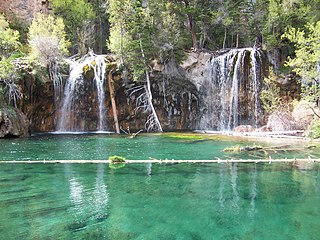
Hanging Lake is a lake in the U.S. State of Colorado. It is located in Glenwood Canyon, about 7 miles (11 km) east of Glenwood Springs, Colorado and is a popular tourist destination. When open, the lake is reached via a trailhead located along the Glenwood Canyon Bike and Pedestrian Path that runs along the north side of I-70 in the bottom of the canyon. The trail follows Dead Horse Creek, a tributary of the Colorado River and ascends some 1,000 feet (300 m) in elevation for 1.2 miles (1.9 km) from the trailhead to the lake.

Rugova Canyon or Rugova Gorge is a river canyon near Peja in Western Kosovo, in the Albanian Alps, close to the border with Montenegro. With a length of 25 km (16 mi) and a depth up to 1,000 meters, Rugova is considered to be one of Europe's longest and deepest canyons. It was created by water erosion and the retreat of the Peja glacier. The Lumbardhi i Pejës river cuts through the canyon.

Havasu Creek is a stream in the U.S. state of Arizona associated with the Havasupai people. It is a tributary to the Colorado River, which it enters in the Grand Canyon.
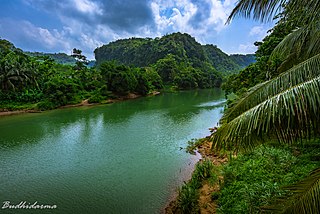
Kaso River, also known as Ci Kaso is a river in Sukabumi Regency, West Java, Indonesia, about 140 km south of the capital Jakarta.

Huápoca is an archaeological site located 36 kilometers west of Ciudad Madera, in the Huápoca Canyon region, northwest of the Mexican state of Chihuahua.
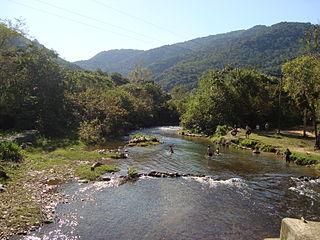
The Alto Ribeira Tourist State Park is a state park in the state of São Paulo, Brazil. It protects a mountainous area of Atlantic Forest and is known for its many caves.

Pangandaran Regency is a Regency in West Java province, Indonesia, formed on 25 October 2012 out of the former southern portion of Ciamis Regency. The population of this area as at the 2010 Census was 383,848, and was 423,670 at the 2020 Census; the official estimate as at mid 2022 was 432,380. The administrative capital is the town of Parigi.
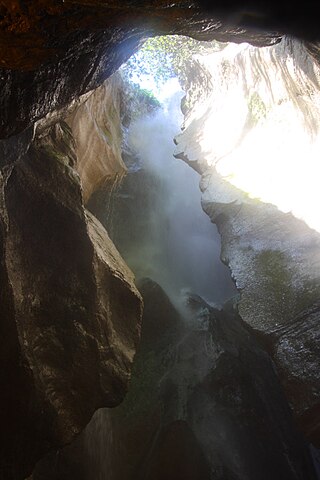
The Cascate del Varone are pair of waterfalls that fall into a vertical cave located 3 kilometers north-west of the northern end of Lake Garda and the city of Riva del Garda in northern Italy. The name Varone has its origin from the town of Varone a short distance away.

Mirusha Park is a regional park located in the central part of Kosovo on the eastern side of the Dukagjin Plain.
Buniayu Cave is a tourist destination area known for its caves adventure. Located on an area of approximately 10 hectares, Buniayu is located in the village of Kerta Angsana, Sukabumi, West Java, Indonesia.

Gachedili Canyon Natural Monument also known as Abasha Canyon Natural Monument and Martvili Canyon is an Abasha river erosion canyon located in Samegrelo region of Western Georgia in Martvili Municipality near Gachedili village, 240 meters above sea level. The water in the Abasha river has deep green color in the canyon. The Gachedili Canyon Natural Monument is located 6 km from the popular Balda Canyon Natural Monument. A canyon visitor center is located in the village Great Inchkhuri on the northern outskirts of the Martvili.

Banjar Station (BJR) is a railway station located in Hegarsari, Pataruman, Banjar, West Java, Indonesia. The station has six railway tracks.






















